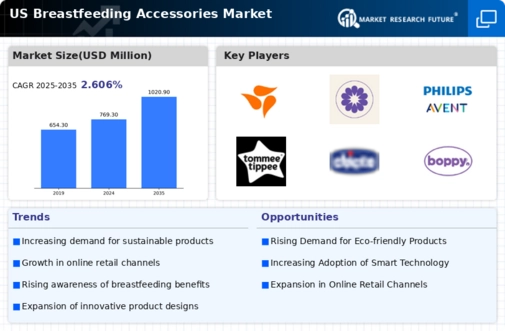Rising Disposable Income
The increase in disposable income among US households is a notable driver for the breast feeding-accessories market. As families experience improved financial stability, they are more inclined to invest in high-quality breastfeeding products that enhance convenience and comfort. Market data indicates that the average spending on baby-related products, including breastfeeding accessories, has risen by approximately 15% over the past few years. This trend suggests that consumers are willing to pay a premium for innovative and effective breastfeeding solutions. Consequently, the breast feeding-accessories market is likely to benefit from this shift in consumer spending habits, as parents prioritize quality and functionality in their purchasing decisions.
Government Support and Initiatives
Government policies and initiatives aimed at promoting breastfeeding are significantly influencing the breast feeding-accessories market. Programs such as the Women, Infants, and Children (WIC) program provide resources and support for breastfeeding mothers, including access to essential accessories. Additionally, legislation mandating breastfeeding-friendly environments in workplaces has encouraged more mothers to breastfeed, thereby increasing the demand for related products. The US government has reported that approximately 60% of mothers return to work within the first year after childbirth, highlighting the need for convenient breastfeeding solutions. This supportive framework is likely to bolster the breast feeding-accessories market as more mothers seek products that facilitate breastfeeding in various settings.
Increasing Awareness of Breastfeeding Benefits
The rising awareness regarding the health benefits of breastfeeding for both infants and mothers is a crucial driver for the breast feeding-accessories market. Educational campaigns and healthcare initiatives have emphasized the advantages of breastfeeding, such as improved immunity for infants and reduced health risks for mothers. This heightened awareness has led to an increase in breastfeeding rates, which, according to recent data, stands at approximately 84% among new mothers in the US. Consequently, the demand for various accessories, including breast pumps, nursing pads, and storage bags, has surged. The breast feeding-accessories market is thus experiencing growth as more mothers seek to enhance their breastfeeding experience with supportive products.
Innovations in Product Design and Functionality
Innovations in product design and functionality are transforming the breast feeding-accessories market. Manufacturers are increasingly focusing on creating ergonomic, user-friendly products that cater to the diverse needs of breastfeeding mothers. For instance, advancements in breast pump technology have led to quieter, more efficient models that enhance the breastfeeding experience. Additionally, the introduction of multifunctional accessories, such as nursing covers that double as car seat covers, reflects a growing trend towards convenience and versatility. Market analysis suggests that the demand for innovative breastfeeding products is on the rise, as mothers seek solutions that simplify their breastfeeding journey. This trend is likely to propel the breast feeding-accessories market forward as new products continue to emerge.
Influence of Social Media and Online Communities
The impact of social media and online communities on the breast feeding-accessories market cannot be overlooked. Platforms such as Instagram and Facebook have become vital spaces for mothers to share their breastfeeding journeys, tips, and product recommendations. This digital word-of-mouth marketing has led to increased visibility for various breastfeeding accessories, driving consumer interest and sales. Research indicates that approximately 70% of new mothers in the US engage with online parenting communities, which often discuss and promote breastfeeding products. As a result, the breast feeding-accessories market is likely to see continued growth as social media influences purchasing decisions and fosters a supportive environment for breastfeeding mothers.

























Leave a Comment